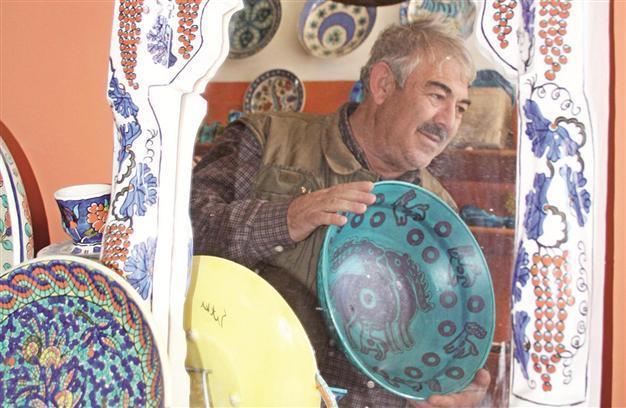Master of tile to survive at a museum in his hometown
KÜTAHYA - Hürriyet Daily News

Sıtkı Olçar’s tile works have been kept in many private collections and museums in Turkey and the world. AA Photo
Turkey’s world famous tile master Sıtkı Olçar, who died in 2010 at the age of 62, will be kept alive at a museum in his hometown, the Aegean province of Kütahya, Anadolu Agency has reported. A protocol was signed by the municipality and Olçar’s daughter on June 26 for the establishment of the museum.
At a ceremony held at Keler Mansion, Kütahya Mayor Mustafa İça and Nida Olçar signed the protocol.
İça said all preparations had been made for the establishment of the museum, revealing that the museum would be established at a restored historical mansion next to the Kemer Bath in the Maruf neighborhood.
“The municipal assembly has bought and restored this place that we called Sipahi Mansion. Works by this late tile master will be exhibited. It is not possible to establish such a museum without the permission of the family, and the family approved our decision to open a museum and also liked the venue. We have finally removed all handicaps by receiving the permission of the Kütahya cultural and Natural Heritage Preservation Board. Now we will apply to the Culture and Tourism Ministry. When the transactions are done, we will deliver the building to the family. The family will be able to intervene and make changes in the museum when necessary,” İça said.
Prime Minister ordered for the museumPrime Minister Recep Tayyip Erdoğan ordered the establishment of a museum after Sıtkı Olçar died in November 2010, daughter Olçar had previously said. However, she has also complained about delays caused by bureaucratic handicaps for the establishment of the museum.
Sıtkı Olçar, born in Kütahya in 1948, opened a studio called “Ottoman Tile” in 1973 in İznik. As time went on, he delved into the traditional tiling and ceramics of his home town and his adopted town of İznik. From 1980 onwards he concentrated more on İznik tiles and trying to reproduce the coral red favored in Ottoman times.
He opened an exhibition in Bursa in 1980, the first of many in Turkey and internationally. He used old designs and forms in his works, taking up examples from İznik and Kütahya. He gave them new life in his interpretations, especially bringing a new dimension and dynamism to Kütahya tile-making, previously thought to have been lost.

Olçar visited many museums abroad and met with many artists, designers and collectors throughout the years. Examples of his works are held in many private collections and museums. In his tiling, he was influenced by the traditional work of İznik and Kütahya, but he also sought new forms.
Olçar also worked hard to discover the secret of how to mix colors to produce the famous coral red, which was lost for 300 years and brought a new approach to the ceramics of Kütahya. He died in November 2010 of pancreatic cancer.
Olçar’s tiles decorate many locations, including the lobby of the Istanbul Stock Exchange with a 24-meter tile panel, and the lobbies of Koç Group’s Talia Hotel and the Ece Palace Hotel in Fethiye. As a leading name in the art of tile making, Olçlar uses traditional motifs and methods, and he has been decorating numerous houses in Turkey and abroad for over 30 years.

 Olçar visited many museums abroad and met with many artists, designers and collectors throughout the years. Examples of his works are held in many private collections and museums. In his tiling, he was influenced by the traditional work of İznik and Kütahya, but he also sought new forms.
Olçar visited many museums abroad and met with many artists, designers and collectors throughout the years. Examples of his works are held in many private collections and museums. In his tiling, he was influenced by the traditional work of İznik and Kütahya, but he also sought new forms.